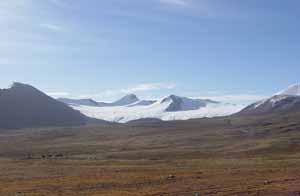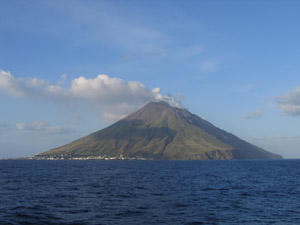Plate Boundaries: convergent
Tibetian Plateau, part of the Himalayas. An example of collision between Indian and Eurasian continental plates
Image Credit: Hucai Zhang, Nanjing
Stromboli Volcano results due to convergence of the Eurasian with the African Plate
Image Credit: MBG
Taal Volcano (Phillipines) results due to convergence of the Phillipines and Eurasian plates
Image Credit: MBG
b) Convergent plate boundaries and subduction
At spreading centers, new lithosphere is continually being generated. However, since the total area of earth remains constant, lithosphere must also be destroyed. The zones of plate convergence are these sites of this destruction. At these zones, the denser plate sinks below the less denser plate (at a velocity of a few cm per year), which itself remains floating above the asthenosphere. This geodynamic process, occurring along deep-sea trenches, is called subduction. The enormous forces which occur during this process produce great earthquakes. Material scraped off the descending plate is incorporated into the adjacent mountains as microplates or accreted terranes. When the subducting oceanic plate reaches a depth of about 100 kilometers, partial melting of the water-rich oceanic crust and some of the overlying mantle takes place. The newly formed magma created in this manner is less dense than the surrounding mantle rocks and, consequently, when sufficient quantities have gathered, will slowly rise. Most of the rising magma will be emplaced in the overlying continental crust, where it will cool and crystallize at a depth of several kilometers. The remaining magma will eventually migrate to the surface where it can give rise to numerous and occasionally explosive volcanic eruptions along a volcanic arc.
A volcanic arc is usually formed by a chain of volcanoes. It parallels the trench approximately 100 km inland. When two oceanic plates collide against each other, the older and therefore heavier of the two subducts beneath the other, initiating volcanic activity in a manner similar to that which occurs at an oceanic-continental convergent plate boundary and forming a volcanic island arc.
Where two continents approach each other, the intervening sea-floor is subducted, causing arc-type volcanism. With collision of the two continental plates, subduction ceases because neither of the continental plates will subduct beneath each other. The result is a collision between two continental blocks. During this collision, the continental crust is folded, stacked and thickened , and generally shortened. A wide zone of intense deformation develops at this boundary. This boundary is marked by a mountain range which often appears as a magmatic belt along a suture. The whole process of mountain formation in which continental crust may thicken to up to 70 km (e.g. Himalayas) is called orogenesis.


